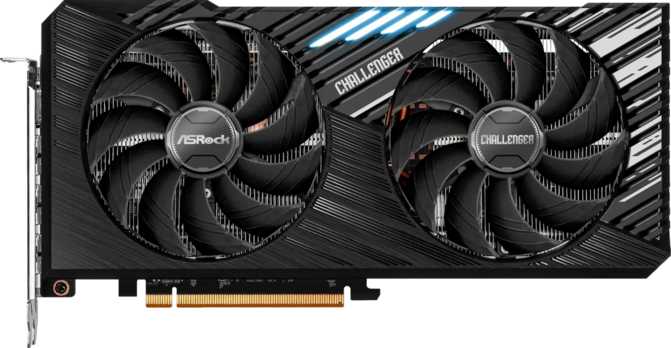ASRock Radeon RX 7900 GRE Challenger OC vs Palit GeForce RTX 4070 GamingPro OC
Performance
GPU clock speed
The graphics processing unit (GPU) has a higher clock speed.
- ASRock Radeon RX 7900 GRE Challenger OC 1500
-
- Palit GeForce RTX 4070 GamingPro OC 1920MHz
-
GPU turbo
When the GPU is running below its limitations, it can boost to a higher clock speed in order to give increased performance.
- ASRock Radeon RX 7900 GRE Challenger OC 2290
-
- Palit GeForce RTX 4070 GamingPro OC 2595MHz
-
Pixel rate
The number of pixels that can be rendered to the screen every second.
- ASRock Radeon RX 7900 GRE Challenger OC 439.7
-
- Palit GeForce RTX 4070 GamingPro OC 166.1 GPixel/s
-
Floating-point performance
Floating-point performance is a measurement of the raw processing power of the GPU.
- ASRock Radeon RX 7900 GRE Challenger OC 46.89
-
- Palit GeForce RTX 4070 GamingPro OC 30.56 TFLOPS
-
Texture rate
The number of textured pixels that can be rendered to the screen every second.
- ASRock Radeon RX 7900 GRE Challenger OC 732.8
-
- Palit GeForce RTX 4070 GamingPro OC 477.5 GTexels/s
-
GPU memory speed
The memory clock speed is one aspect that determines the memory bandwidth.
- ASRock Radeon RX 7900 GRE Challenger OC 2250
-
- Palit GeForce RTX 4070 GamingPro OC 1313MHz
-
Shading units
Shading units (or stream processors) are small processors within the graphics card that are responsible for processing different aspects of the image.
- ASRock Radeon RX 7900 GRE Challenger OC 5120
-
- Palit GeForce RTX 4070 GamingPro OC 5888
-
Texture mapping units (TMUs)
TMUs take textures and map them to the geometry of a 3D scene. More TMUs will typically mean that texture information is processed faster.
- ASRock Radeon RX 7900 GRE Challenger OC 320
-
- Palit GeForce RTX 4070 GamingPro OC 184
-
Render output units (ROPs)
The ROPs are responsible for some of the final steps of the rendering process, writing the final pixel data to memory and carrying out other tasks such as anti-aliasing to improve the look of graphics.
- ASRock Radeon RX 7900 GRE Challenger OC 192
-
- Palit GeForce RTX 4070 GamingPro OC 64
-
Memory
Effective memory speed
The effective memory clock speed is calculated from the size and data rate of the memory. Higher clock speeds can give increased performance in games and other apps.
- ASRock Radeon RX 7900 GRE Challenger OC 18000
-
- Palit GeForce RTX 4070 GamingPro OC 21000MHz
-
Maximum memory bandwidth
This is the maximum rate that data can be read from or stored into memory.
- ASRock Radeon RX 7900 GRE Challenger OC 576
-
- Palit GeForce RTX 4070 GamingPro OC 504GB/s
-
VRAM
VRAM (video RAM) is the dedicated memory of a graphics card. More VRAM generally allows you to run games at higher settings, especially for things like texture resolution.
- ASRock Radeon RX 7900 GRE Challenger OC 16
-
- Palit GeForce RTX 4070 GamingPro OC 12GB
-
GDDR version
Newer versions of GDDR memory offer improvements such as higher transfer rates that give increased performance.
- ASRock Radeon RX 7900 GRE Challenger OC gddr6
- Palit GeForce RTX 4070 GamingPro OC gddr6x
Memory bus width
A wider bus width means that it can carry more data per cycle. It is an important factor of memory performance, and therefore the general performance of the graphics card.
- ASRock Radeon RX 7900 GRE Challenger OC 256
-
- Palit GeForce RTX 4070 GamingPro OC 192bit
-
Features
DirectX version
DirectX is used in video games, with newer versions supporting better graphics and features. The latest version is DirectX 12 Ultimate, which includes support for ray tracing, mesh shaders, and variable rate shading (VRS).
- ASRock Radeon RX 7900 GRE Challenger OC null
-
- Palit GeForce RTX 4070 GamingPro OC 12
-
OpenCL version
Some apps use OpenCL to apply the power of the graphics processing unit (GPU) for non-graphical computing. Newer versions introduce more functionality and better performance.
- ASRock Radeon RX 7900 GRE Challenger OC 2.2
-
- Palit GeForce RTX 4070 GamingPro OC 3
-
Supports DLSS
DLSS (Deep Learning Super Sampling) is an upscaling technology powered by AI. It allows the graphics card to render games at a lower resolution and upscale them to a higher resolution with near-native visual quality and increased performance. DLSS is only available on select games.
- ASRock Radeon RX 7900 GRE Challenger OC
- Palit GeForce RTX 4070 GamingPro OC
AMD SAM / Intel Resizable BAR
AMD's Smart Access Memory (SAM) and Intel's Resizable BAR are two technologies that allow the CPU to have faster access to the graphics card, which can give a performance boost. It requires a compatible motherboard, graphics card, and CPU.
- ASRock Radeon RX 7900 GRE Challenger OC sam
- Palit GeForce RTX 4070 GamingPro OC bar
General info
Thermal Design Power (TDP)
The thermal design power (TDP) is the maximum amount of power the cooling system needs to dissipate. A lower TDP typically means that it consumes less power.
- ASRock Radeon RX 7900 GRE Challenger OC 260
-
- Palit GeForce RTX 4070 GamingPro OC 215W
-
Number of transistors
A higher transistor count generally indicates a newer, more powerful processor.
- ASRock Radeon RX 7900 GRE Challenger OC 57700
-
- Palit GeForce RTX 4070 GamingPro OC 35800%{count} million
-
Width
The width represents the horizontal dimension of the product.
- ASRock Radeon RX 7900 GRE Challenger OC 269
-
- Palit GeForce RTX 4070 GamingPro OC 328.9mm
-
Height
The height represents the vertical dimension of the product.
- ASRock Radeon RX 7900 GRE Challenger OC null
-
- Palit GeForce RTX 4070 GamingPro OC 132.9mm
-

